Transform your basement into an efficient food storage haven by focusing on four key elements: temperature, humidity, ventilation, and pest control. You'll want to maintain temperatures between 50-70°F and keep humidity levels at 30-50% using proper insulation and dehumidifiers. Install adjustable shelving units and use clear, airtight containers for organized storage while ensuring proper air circulation. Set up a regular cleaning schedule and inspect for moisture or pest issues weekly. With the right setup, your basement can become a cost-effective, sustainable solution for long-term food preservation—and there's much more to discover about maximizing your underground storage space.
Why Choose Underground Storage
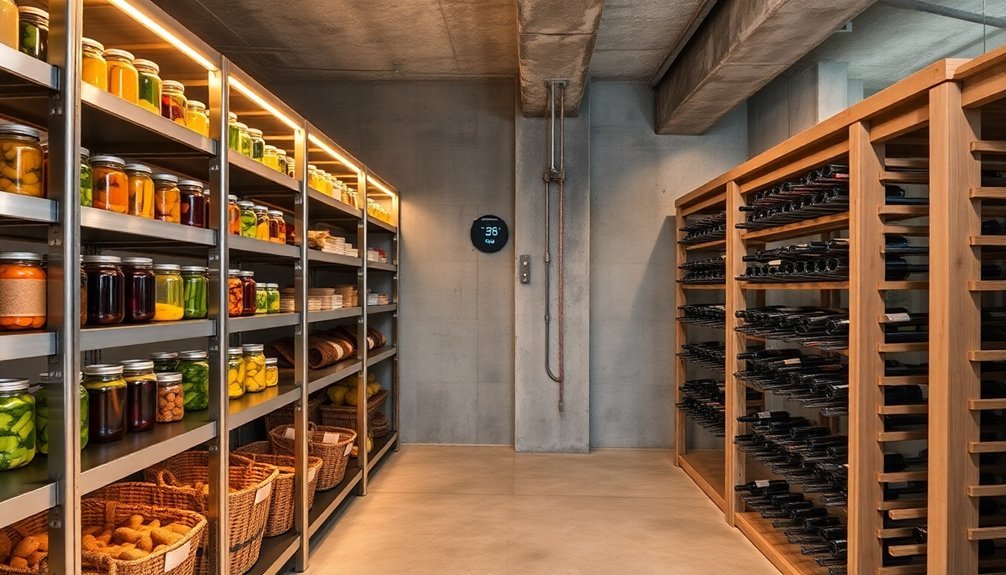
Many practical and financial benefits make underground storage an attractive option for food preservation.
You'll notice significant cost savings compared to above-ground storage, with lease rates up to 50% lower and construction costs about one-third less. Your utility bills will drop dramatically, with some facilities reporting winter savings of $50,000 monthly, and you'll pay considerably lower taxes – just 30 cents per square foot versus up to $1.60 above ground.
The environment in underground storage remains remarkably stable, maintaining temperatures between 68-72 degrees year-round with humidity levels below 55%. The solid rock roofs protect against water damage and weather-related issues.
You won't have to worry about external weather conditions affecting your stored goods, and your food will maintain its quality longer due to these consistent conditions.
Your underground space can accommodate various storage needs, from perishables to dry goods, and it's easily accessible for transportation.
You'll also contribute to sustainability efforts, as underground storage naturally reduces your carbon footprint through minimal energy requirements.
The earth's natural insulation eliminates the need for extensive artificial climate control, making it an environmentally responsible choice while extending your food's shelf life.
Assessing Your Basement Space
A thorough basement assessment forms the foundation of successful food storage. Before you transform your space, you'll need to evaluate essential environmental factors that could affect your food's longevity. Check for dampness by inspecting walls and floors, guarantee proper ventilation exists, and monitor temperature consistency throughout the area. Consider selecting an area that allows for sturdy shelving setup to accommodate heavy food items safely.
| Assessment Area | What to Look For |
|---|---|
| Environment | Moisture levels, air circulation, temperature stability |
| Space Layout | Distance from heat sources, accessible pathways, corner utilization |
| Storage Points | Wall space for shelving, floor strength for heavy items |
When mapping out your storage layout, consider both vertical and horizontal spaces. You'll want to designate prime locations for frequently accessed items while maximizing corner spaces with custom shelving solutions. Don't forget to plan for specialized storage needs, such as root cellars for produce or dry areas for grains.
Remember to factor in maintenance access and future expansion possibilities. You'll need clear pathways to clean and organize your storage areas, and it's wise to leave room for additional shelving as your storage needs grow. Consider installing hygrometers to monitor humidity levels and guarantee your basement maintains ideal storage conditions.
Essential Temperature Control Methods
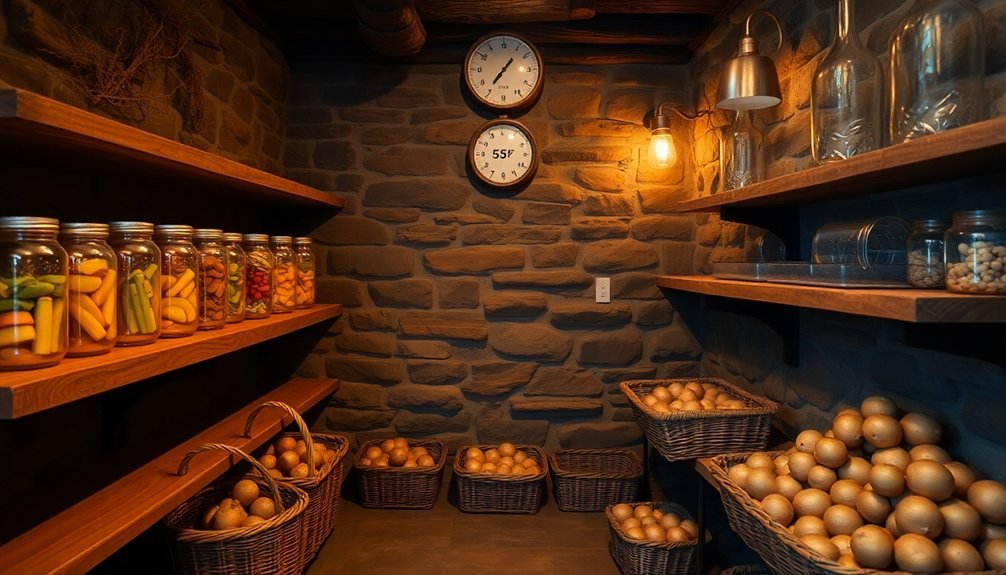
Three critical factors drive successful basement food storage: temperature, airflow, and monitoring. To maintain the ideal temperature range of 32-40°F (0-4°C), you'll need to implement targeted control methods that work with your basement's natural conditions.
Start by insulating your basement walls and ceiling while sealing any gaps that could let cool air escape. Install a two-vent system to regulate airflow, with one vent near the floor for cool air intake and another near the ceiling for warm air release. A wooden shelf system can help manage moisture levels in your basement storage area.
You'll want to insulate any overhead ductwork to prevent unwanted heat transfer into your storage area. If you're in a warmer climate, use window treatments to block direct sunlight and consider opening windows at night to capture cooler air.
Install a thermometer and hygrometer to track both temperature and humidity levels, aiming for 85-95% relative humidity. Use fans strategically to maintain consistent air circulation throughout your storage space.
Don't forget to check your stored items regularly for signs of spoilage and adjust your ventilation as needed during extreme weather conditions. During particularly cold spells, you may need to temporarily cover vents to prevent freezing.
Mastering Humidity Levels
You'll need to monitor your basement's humidity levels daily using a hygrometer, aiming for a range between 30-50% to protect your food storage.
Consider natural methods first, such as improving ventilation and sealing foundation cracks, before moving on to mechanical solutions.
When using dehumidifiers, place them centrally in your basement's dampest area and make sure they're elevated off the floor to maximize their effectiveness.
Monitor Daily Moisture Levels
Two essential tools can help you effectively monitor basement moisture levels: moisture meters and hygrometers. You'll need both to guarantee your food storage area maintains ideal conditions, as each device serves a distinct purpose in moisture detection.
For precise spot-checking, use a pin-type moisture meter to test specific areas of your walls, floors, and storage shelves. Insert the pins into the material you're testing, but avoid using this method on finished surfaces since it'll leave small holes.
When you need to scan larger areas without causing damage, opt for a pinless moisture meter that uses electromagnetic waves.
Track your basement's relative humidity daily using a digital hygrometer – you'll want to maintain levels between 30-50% to prevent mold growth and protect your stored food.
Consider investing in a modern thermo-hygrometer that combines temperature and humidity readings, or choose a Bluetooth-enabled device that'll sync with your smartphone for easy monitoring and record-keeping.
Look for patterns in your readings and conduct regular visual inspections for water stains or musty odors.
When you notice consistently high readings or concerning patterns, you'll know it's time to investigate further and address potential moisture issues before they compromise your food storage.
Natural Humidity Control Methods
Several natural methods can effectively control basement humidity without relying on mechanical dehumidifiers.
You'll want to start by strategically using your windows – open them during dry weather to promote air circulation, but keep them closed when it's humid outside to prevent moisture buildup. If you're dealing with low humidity, place a shallow pan of water in the space or lightly mist the area with a spray bottle.
For produce storage, you can pack vegetables in damp sawdust, sand, or moss to maintain proper moisture levels.
If you have a dirt or gravel floor, utilize the natural ground moisture to your advantage. When storing root vegetables in the fall, sprinkle the floor or use damp burlap bags to create the right environment.
Don't forget to maintain proper temperature control, as it directly affects humidity. Keep the basement slightly warmer to prevent moisture accumulation, and insulate between your house and storage area to maintain consistent conditions.
Always guarantee good airflow by keeping storage items away from walls, and seal any cracks or gaps that could allow unwanted moisture infiltration.
Remember to regularly inspect your foundation and maintain proper grading to direct water away from your basement.
Dehumidifier Placement Tips
Proper placement of your dehumidifier plays an essential role in maintaining ideal basement humidity levels. Position your unit in the largest open area of your basement, ideally in the center, to maximize air circulation and effectiveness. If you've got multiple rooms, you'll need additional smaller units to guarantee thorough coverage.
To enhance your dehumidifier's performance, pair it with a box fan or oscillating fan for better air movement. You'll want to maintain humidity levels between 40-50% RH while making sure they never exceed 65% to prevent mold growth.
| Location Factor | Best Practice |
|---|---|
| Open Space | Center of largest area |
| Multiple Rooms | Use additional units |
| Air Flow | Add circulation fans |
| Drainage | Near sump pump/floor drain |
| Ventilation | Away from windows |
Don't forget to connect your unit directly to a drain system for continuous operation. Keep an eye on performance by using a hygrometer to monitor actual humidity levels. Regular maintenance, including cleaning and checking insulation around the unit, will guarantee peak efficiency. For coastal or high-humidity environments, choose a unit specifically rated for these conditions to handle the additional moisture load effectively.
Ventilation and Air Flow
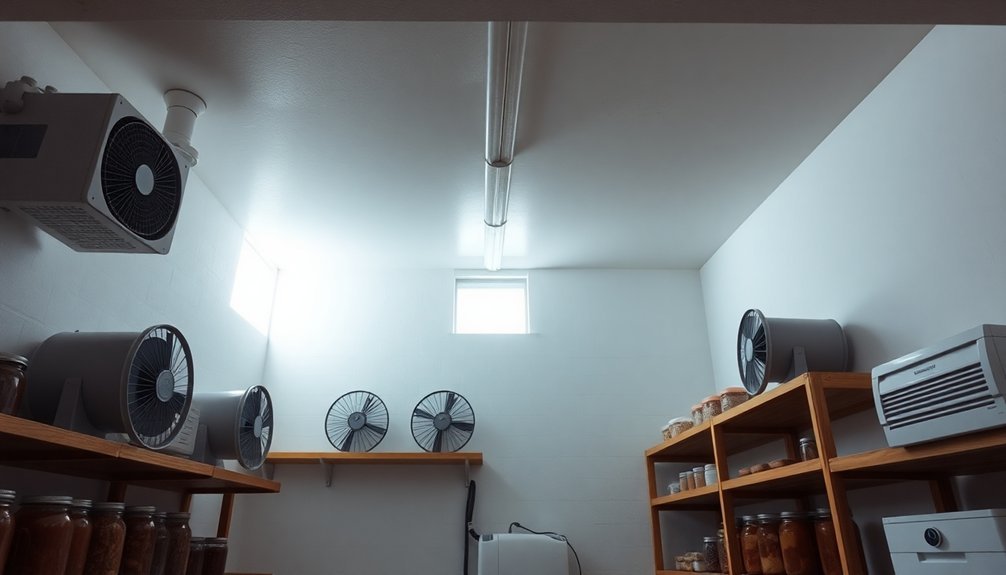
Inside a basement food storage area, ventilation serves as the cornerstone of successful preservation. You'll need to install a dual vent system with 3-4 inch diameter openings – one near the ceiling for exhaust and another near the floor for intake.
Position these vents on opposite walls to maximize air circulation and cover them with screens to keep pests out.
Make sure you're taking advantage of natural convection by allowing cool air to enter through the lower vent while warm air escapes through the upper one. You can enhance this airflow by elevating your storage crates a few inches off the floor and using ceiling-mounted wire shelves.
Don't create an airtight environment, as this will trap humidity and ethylene gas. Monitor your ventilation system regularly and adjust the vents before freezing temperatures arrive.
You'll want to seal any gaps between ducts and walls with silicone caulk, but maintain proper airflow to prevent mold and mildew. If natural ventilation isn't sufficient, consider installing an exhaust fan.
For cold climates, replace window glass with insulated panels made from plywood and polystyrene foam to accommodate vent pipes while maintaining temperature control.
Building Effective Storage Systems
To make the most of your basement food storage space, start by installing adjustable shelving units from floor to ceiling that let you maximize vertical storage potential.
When selecting containers, choose stackable, clear storage bins that allow you to see contents easily while making efficient use of shelf depth and height.
Label each container clearly and organize them by food type and expiration date to create an intuitive system that's easy to maintain.
Maximize Vertical Space Usage
Making the most of vertical space stands as an essential strategy when organizing basement storage. You'll want to install floor-to-ceiling shelving units with varying heights to accommodate different food items while creating an efficient storage system. Guarantee your shelves are sturdy enough to support heavy canned goods and bulk items, and consider adding adjustable shelves to adapt to your changing storage needs.
Don't overlook your walls – they're valuable real estate for built-in storage systems. You can install closed cabinets to protect sensitive food items while maintaining a clean appearance, and incorporate open shelving for quick access to frequently used goods. Adding proper lighting will help you easily locate items and keep your storage area well-illuminated.
Your ceiling space offers additional storage potential. Install overhead racks for less frequently accessed items, but always adhere to weight limits for safety. Use clear, labeled bins to quickly identify stored foods from below.
If you're working with limited floor space, consider installing a sliding ladder system to safely reach items stored in higher areas. This vertical approach maximizes your storage capacity while maintaining an organized, accessible food storage system.
Smart Container Selection
Selecting the right containers forms the foundation of an effective basement food storage system. You'll want to prioritize borosilicate glass containers that can withstand extreme temperatures from -4°F to 752°F, making them perfect for long-term storage. Choose containers with polypropylene lids and food-grade silicone seals to guarantee your food stays fresh and protected.
For tech-savvy storage, opt for smart containers equipped with QR codes that connect to mobile apps. You can track your inventory, monitor expiration dates, and receive automated notifications about food safety. These containers will help you manage your food storage more efficiently while providing valuable nutrition information through barcode scanning.
Maximize your storage efficiency by selecting containers with removable handles for easy stacking. You'll appreciate containers that are dishwasher safe and BPA-free, guaranteeing both convenience and safety.
If you're on a budget, consider repurposing food-grade plastic buckets from bakeries or grocery stores. Glass canning jars are also excellent options, provided they're free from chips and cracks.
Remember to inspect your containers regularly for damage and replace them as needed to maintain food safety standards.
Perfect Foods for Underground Storage
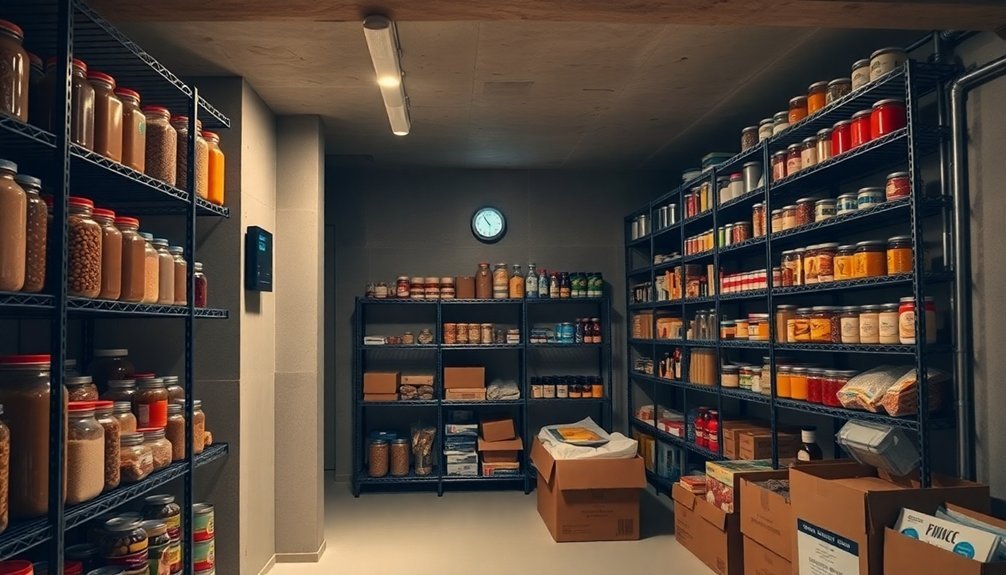
From root vegetables to preserved goods, the ideal foods for underground storage share several key characteristics that make them perfect for long-term basement storage.
You'll want to focus on underground storage organs like potatoes, beets, carrots, and onions, as their natural durability makes them excellent candidates for your basement pantry.
Store your root vegetables according to their temperature requirements. Keep temperate crops like carrots and beets near 0°C, while subtropical crops like potatoes need slightly warmer temperatures around 4°C to prevent chilling injury. For tropical crops, maintain temperatures between 12-13°C, except for cassava, which you'll want to store at 0-5°C.
Don't forget to stock up on shelf-stable processed foods. You can't go wrong with canned goods, which will last for years when stored properly in your cool basement.
Add dried legumes, energy bars, and nuts to your storage plan – they're nutritionally dense and have impressive shelf lives. These foods are particularly valuable because they're low in moisture content, making them less susceptible to spoilage, while providing essential nutrients like protein, vitamins, and minerals for your long-term food security.
Pest Prevention Strategies
Protecting your basement food storage from unwanted pests requires an all-encompassing defense strategy. Start by thoroughly examining your storage area for potential entry points, sealing all cracks and holes with appropriate materials.
Don't forget to insulate walls and pipes to prevent condensation, and apply waterproof paint if needed to combat moisture issues.
Choose your storage containers wisely. Opt for air-tight glass containers or metal bins with latching lids instead of plastic ones that pests can chew through. Keep these containers elevated on shelves or pallets to improve air circulation and make regular inspections easier.
Label everything clearly to maintain organization and spot problems quickly.
Maintain proper ventilation using dehumidifiers or ventilation systems to control moisture levels that attract pests. Clean your storage area regularly, addressing spills and food debris immediately.
Set up strategic defenses by placing humane traps near entry points and using natural deterrents like cayenne pepper for larger pests. Remember to keep food items separated to prevent cross-contamination and contain potential spoilage.
Implement a consistent cleaning and inspection schedule to catch any pest issues before they become serious problems.
Maintaining Your Storage Haven
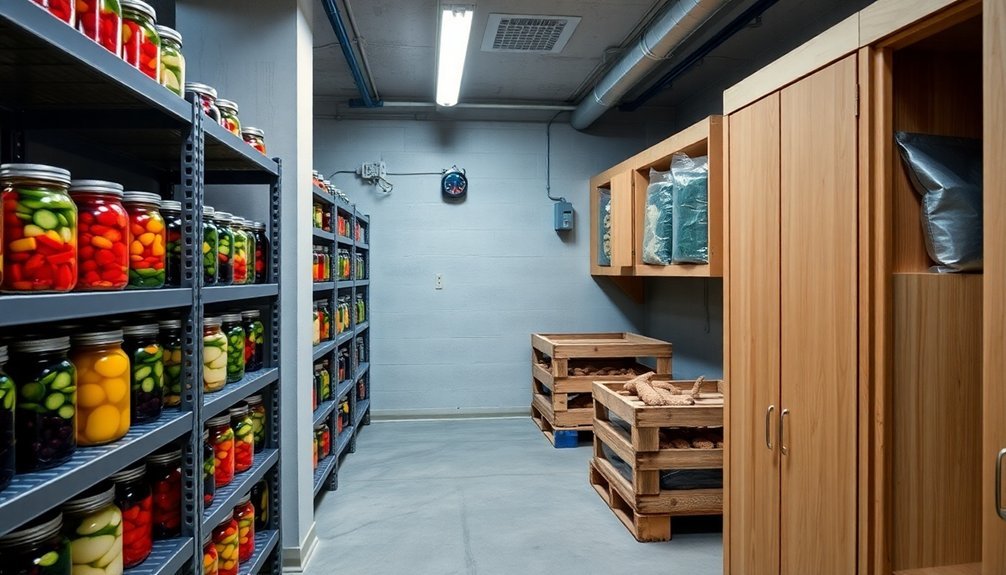
Once you've secured your storage space against pests, maintaining ideal conditions becomes your next priority.
You'll need to focus on proper insulation to keep temperatures between 50-70 degrees Fahrenheit while maintaining high humidity levels for root vegetables. Use materials like straw bales or foam board to insulate walls and ceilings effectively.
Ensure your storage area has adequate ventilation to prevent ethylene gas buildup and maintain consistent conditions. Keep your stored items at least 6 inches from walls and floors, and 12 inches from the ceiling to promote proper air circulation.
You'll want to organize your space using labeled baskets or bins, keeping ethylene-producing vegetables separate from ethylene-sensitive ones.
Make maintenance a regular habit by cleaning floors, walls, and shelving areas consistently. When you spot spills or leaks, clean them immediately to prevent contamination.
Don't forget to inspect your stored items regularly for signs of spoilage, removing any affected produce promptly. Keep your storage haven in top condition by sanitizing surfaces and repairing any cracks or crevices that could compromise your storage environment.
Common Basement Storage Challenges
While basement storage offers valuable space for your food supplies, several common challenges can impact its effectiveness. You'll need to address accessibility issues by avoiding overstacking containers and making sure frequently used items remain within easy reach. Don't place heavy items on upper shelves, as this creates safety risks and makes retrieval difficult.
Moisture poses another significant challenge in basement environments. You'll want to implement proper moisture control using dehumidifiers and maintain functional sump pumps. Replace cardboard boxes with waterproof containers and keep items elevated off the floor using shelving units.
| Challenge | Impact | Solution |
|---|---|---|
| Moisture | Food spoilage, mold growth | Use dehumidifiers, waterproof containers |
| Accessibility | Difficult retrieval, safety risks | Implement proper stacking, zone organization |
| Temperature | Food degradation, quality loss | Make sure insulation, maintain ventilation |
| Organization | Wasted time, lost items | Label containers, create storage zones |
For ideal storage conditions, you'll need to maintain proper ventilation and temperature control. Seal any wall or floor gaps, and use strategic insulation to maintain consistent temperatures. Create organized zones for different food types, and implement a clear labeling system to track your inventory effectively.
Seasonal Storage Tips
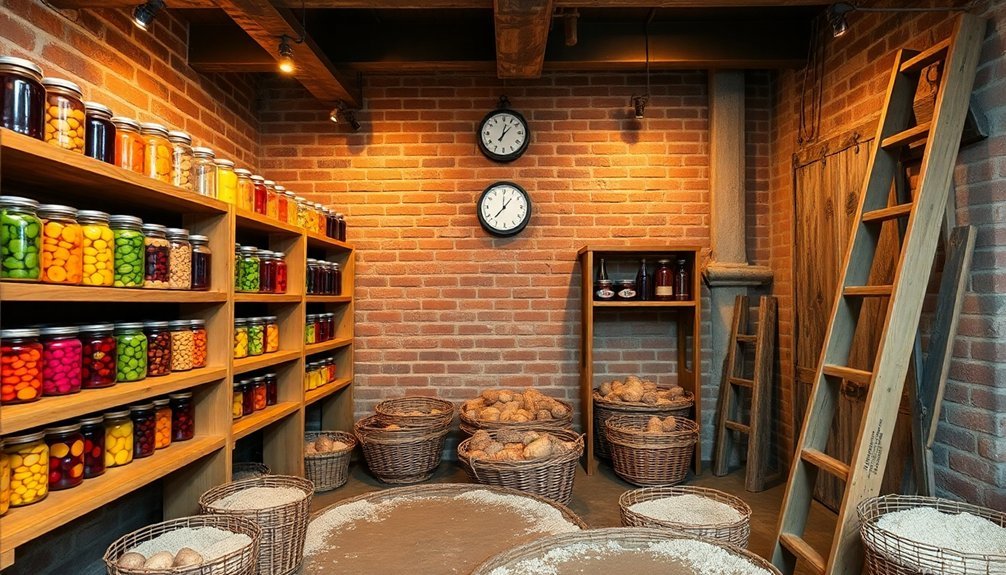
Seasonal changes require different approaches to basement food storage throughout the year.
During summer, you'll need to monitor your ventilation system more closely to maintain the ideal 32-40°F temperature range, as warmer outdoor air can affect your storage conditions. Position your storage bins away from any heating ducts and check humidity levels frequently to guarantee they stay between 80-90%.
In winter, you can take advantage of natural cooling by leaving exterior walls uninsulated, allowing the ground's natural coolness to regulate your storage space.
You'll want to organize your produce strategically during harvest season, placing quick-ripening items like tomatoes in separate areas from long-term storage vegetables. Keep root vegetables in dedicated bins, while storing apples and pears in ventilated containers away from other produce.
Throughout the year, maintain consistent access to your storage area, especially if you've built it under a shed or covered space.
Check your stored items weekly for signs of spoilage, and adjust ventilation as needed to prevent mold growth. Label your storage containers clearly and rotate produce based on harvest dates to maximize shelf life.
Frequently Asked Questions
How Long Can I Store Homemade Wine in My Basement Storage?
You can store your homemade wine for up to five years in your basement if you maintain proper conditions: 45-65°F temperature, 50-70% humidity, and darkness. Red wines need one year, whites need six months minimum.
Can I Use My Underground Storage Space During a Power Outage?
Yes, you can use your underground storage during a power outage. It's naturally cool and maintains consistent temperatures. Just guarantee proper ventilation, keep food grouped together, and monitor temperatures with a thermometer.
Will Strong-Smelling Foods Affect the Taste of Other Stored Items?
Yes, strong-smelling foods will affect nearby items' taste. You'll need to store pungent foods in glass containers and keep them separate from sensitive items like dairy, bread, and fruits to prevent odor absorption.
Should I Tell My Home Insurance Provider About My Basement Storage Setup?
Yes, you should notify your insurance provider about your basement storage setup. It's essential for proper coverage and claim protection. Failing to disclose could result in denied claims if damage occurs.
Can I Store Medical Supplies and Medications in Underground Storage?
You can store medical supplies underground if you maintain proper temperature, humidity control, and ventilation. However, it's critical to monitor conditions closely and guarantee medications are stored according to their specific requirements.
In Summary
Transform your basement into the ultimate food storage space by following these essential steps. You'll create a controlled environment that protects your provisions while maximizing available space. With proper temperature control, humidity management, and pest prevention, you're setting yourself up for long-term storage success. Remember, it's not just about storing food—it's about creating a sustainable solution for your family's food security.

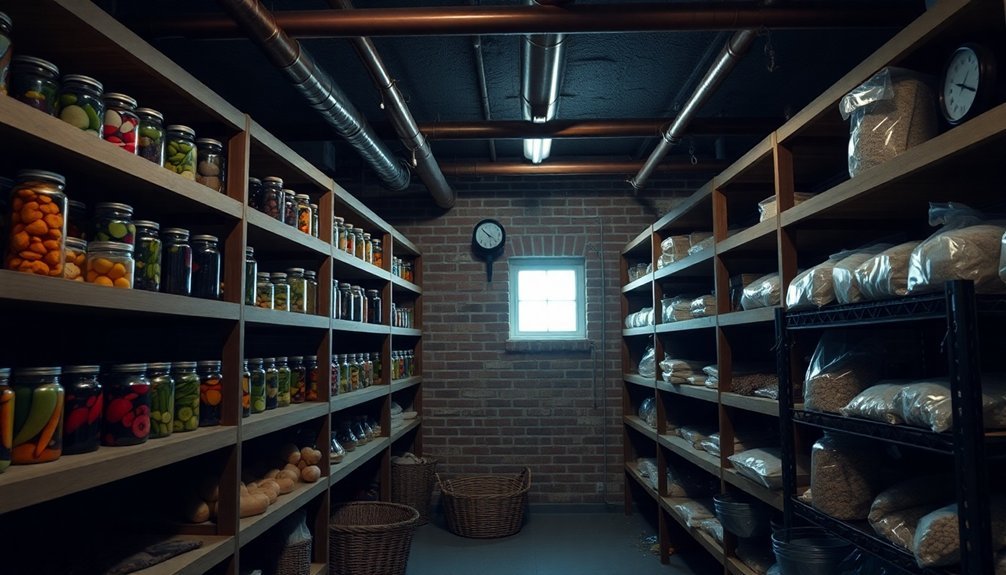



Leave a Reply